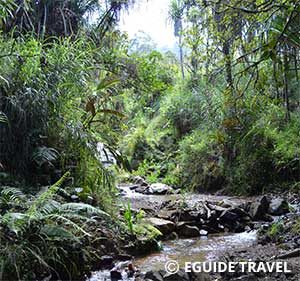Butterfly Farming in Papua New Guinea
by Ken Jansen

Tropical rainforests are often called the 'lungs of the planet', an acknowledgment of their importance to the Earth's atmosphere.
Yet at present rates of deforestation, 65 percent of all these forests, rich in biodiversity, will be lost in 10 years. The statistics -- and the solutions -- seem daunting.
It's a double-edged ax. Large multinational corporations continue business as usual, fueled by lucrative timber dollars. And the environmentalist's argument that rainforests be preserved does little to help villagers who must pay school fees for their children or buy kerosene for their lamp.
So how about some good news for a change?
In the Pacific nation of Papua New Guinea (PNG), land and resources are held in traditional customary title; however, villagers still need a cash income. The government's conventional answer is for the land holder to sell their timber resources. The East Sepik Council of Women (ESCOW) is countering the lure of felling this tempting resource by promoting alternative sources of income. The search is for renewable resources that can be sustainably harvested, leaving the rainforest intact. ESCOW already supports the marketing of traditional string bags, carvings, locally-processed food and other non-timber products. One exciting new income generating opportunity is found in the beauty of the butterfly.
ESCOW, along with the Canadian international development agency CUSO, US-based Christensen Research Institute, and the PNG Insect Farming and Trading Agency, are promoting the village-based industry of raising butterflies. Papua New Guinea has long attracted international collectors for its unique and exotic species of spiders, beetles and insects. PNG is the home to the magnificent Birdwing butterflies, especially the Ornithoptera Alexandrae, the largest and rarest butterfly in the world. It can reach a wingspan of 27 cm and attract a retail price of $US 500.
Birdwings inhabit the sunny rainforest canopy, feeding on nectar-filled flowers growing many metres above ground level. The butterfly only comes to earth when the canopy dips into river channels or natural openings. The typical butterfly farm in PNG is a half-acre of land that was once a productive vegetable garden site previously cleared from the prime forest. The soil may be too depleted to grow corn or sweet potato but is fertile enough to sustain the vines needed for a butterfly garden. The process is simple. First, plant a border of Poinsettia and Hibiscus. Within the flowering border transplant rows of aristolochia and other vines. The border acts to attract and feed the adult specimens who breed and lay eggs on the vines which provide ample food for the offspring. The larvae feed on the vines for four weeks, spin their chrysalis and spend four more weeks in metamorphosis. The farmer observes the food supply, notes the location of his/her caterpillars, and determines the maturation of the chrysalises. About 70 percent of the butterfly chrysalis crop can be harvested and brought into a protected hatching cage. The remaining 30 percent is left on the vine to regenerate and complete their natural life cycle.
With the cultivated garden providing an over-abundance of food, and because human presence discourages natural predation, the population of free flight butterflies is greatly enhanced. The newly emerged caged butterflies are carefully killed, placed in paper envelopes and dried in the sun. When sufficient butterflies have been collected they are packaged and mailed to the Insect Farming and Trading Agency (IFTA) in Bulolo, Morobe Province.
The IFTA inspects, sorts, labels and markets the specimens to buyers around the world. These orders generate US$400,000 for PNG annually. Dr. Peter Clark, Director of IFTA, believes the project re-inforces in villagers that "the environment can be used but not abused, and the forest can serve a good purpose for a longer period than it takes to chop it down. With the right tools [villagers] can make some money yet pass onto their children the same natural treasures they received from their parents."
Wild specimens of common butterflies are sometimes included in the scheme, but most are rejected due to damage sustained in the wild or during capture. Participants are encouraged to farm rather than hunt the butterflies. All Birdwing species are protected from capture in the wild; only individuals with inspected gardens are licensed to sell the rare Ornithoptera Paradisea, Alexandrae, Goliath, Priamus Poseidon or Priamus Urvillanus butterflies.
Blu Riari, a licensed butterfly farmer for 23 years, often receives US$ 100 for a pair of Ornithoptera Paradisea Birdwing butterflies. Supplementing this with the gathering of other desirable leaf insects, walking sticks or rhinoceros beetles, Blu feels that "the village farmer can earn an income equal to those with a steady job in town, and certainly more than from the royalties paid through industrial logging."
The gardens are also bringing these winged jewels of the tropical rainforest closer to humans: a garden can attract outside tourists as effectively as it does butterflies. This eco-tourism in turn creates a need for guest houses, guides for bush walks or river patrols, food preparation and craft sales. And with each of visitor comes another economic reason to maintain the rainforest.
Ken Jansen is a farmer and community activist living in Kleena Kleene, in the Chilcotin area of British Columbia. He worked in PNG through CUSO for 5 years. His last assignment was developing village-based enterprises. Our thanks to Sean Kelly of the Sustainable Times for permission to reprint this article.



